Microsoft’s Surface Pro 4 does not run Android. It’s arguably a tablet, sort of laptop like thing, but it is most definitely not an Android device, so why on earth is it on my desk, and why have I spent the last couple of weeks learning how to use Windows again?
It’s simple, really. As great as Android is, it isn’t a desktop substitute even on the high-end Android tablets. ChromeOS is sort of a desktop substitute, but it really isn’t at the point yet where it’s comparable to Windows or macOS. No, I need some kind of desktop to do my work for Ausdroid (and elsewhere) and with an ageing Macbook Pro, and a fairly boring newly released Macbook Pro from Apple, I thought it was a better idea to see what else was on the market.
Microsoft’s Surface Pro 4 is undoubtedly one of the more popular portable machines on the market. I know that reviews of Windows devices are not why many of you come to Ausdroid, but equally, Android doesn’t exist in a vacuum. For getting work done, sometimes, we have to spread our wings just a little further, and so here’s my thoughts of my time with the Surface Pro 4.
What is it?
Fundamentally, Microsoft’s Surface Pro 4 (herein the Surface for simplicity) is a tablet/laptop hybrid which runs the company’s Windows 10 operating system. It’s versatile and portable enough to be used as a tablet, capable enough to be used as a laptop, and in the higher end configurations, its quite capable as a desktop workstation as well.
While the internal specifications vary, some don’t. Surface has a 12.3″ display, solid state storage up to 1TB, and up to 16GB of DDR3 RAM. In simple terms, it’s more than up to the task of running Windows, Microsoft’s Office suite, Google Chrome, and whatever other apps you care to use on a daily basis.
It probably isn’t a capable gaming machine, but let’s face facts. I’m not a gamer, and so I really don’t care.
Here’s some of the key specifications:
| Specifications | Options |
|---|---|
| Display | 12.3″ PixelSense display at 2,736 x 1,824 (267ppi) |
| Memory | 4GB, 8GB or 16GB |
| Processor | 6th Gen Intel Core m3, i5 or i7 |
| Sensors | Ambient Light Sensor Accelerometer Gyroscope |
| Ports | USB 3.0 MicroSD card reader Surface Connector port Headset jack Mini DisplayPort Cover Port |
| Graphics | Intel HD Graphics 515 or 520, Intel Iris for Core i7 |
| Camera | Windows Hello sign-in camera 5.0MP front-facing camera for HD video 8.0MP rear-facing camera for 1080p video |
| Wireless | 802.11ac WiFi Bluetooth 4.0 |
Starting at $1,349, there’s a range of pricing options which vary based on what you choose to put inside:
- Core m3, 128GB storage, 4GB RAM – $1,349
- Core i5, 128 GB storage, 4GB RAM, $1,499
- Core i5, 256 GB storage, 8GB RAM, $1,999
- Core i7, 256 GB storage, 8GB RAM, $2,499
- Core i7, 256 GB storage, 16GB RAM, $2,799
- Core i7, 512 GB storage, 16GB RAM, $3,399
- Core i7, 1 TB storage, 16GB RAM, $4,199
As you can see there’s a wealth of configuration options, and you might need a reasonable amount of wealth to afford some of the higher end models. On top of those prices, if you want to add the Surface Pro 4 Type Cover (which most of us would call the clip-on keyboard), you need to factor in an additional $199.95, or you can grab one which includes a fingerprint reader for extra secure sign-on for $249.95.
In short, you’re going to be spending a bit of money on a Surface, looking at around $1500 for the base model with a keyboard, all the way up to around $4,450 for the top of the line model. That’s quite a lot to spend on a laptop, much less a tablet/laptop convertible, so the logical question is: is it worth the price, and should I buy one?
Let’s take a look.
What’s it good at?
Our review unit is a Surface with an Intel Core i7 processor at 2.2 GHz, with 8GB of RAM, and 256GB storage. With the keyboard option, its priced around the $2,750 mark.
For my mind, the major selling point of the Surface is its portability. In terms of size, it’s not significantly larger than Google’s Pixel C, and it’s a bit smaller than your average 13″ laptop in both screen-size and overall size (it’s smaller than a Macbook Pro, for example). This makes it rather easy to carry about. It folds nice and flat, and the keyboard cover doubles as a cover (hence the name) to protect the screen a little, so the Surface is quite at home being carried amongst a pile of papers, in your day bag, or sitting on your desk. Hell, using the kick-stand, I even managed to make Surface sit nicely in the top of my steering wheel so I could use it in the car (while stopped, of course).
Being built around solid-state storage, Surface starts incredibly quickly most of the time, but running Windows, start-up is often delayed — such as now, while writing this review — while it installs Windows Updates. Yes, just like the Windows we’ve known and loved (read: hated) for years, Surface is plagued with regular software updates which prevent you from actually using it.
Annoying, but not unique to Surface if we’re being fair, though macOS does this in a more transparent way; you’re prompted to install them, rather than having them automatically download and install without your knowing so.
One of the key selling points of the Surface, versus many other laptops at least, is the touch surface. Supporting up to 10 point multi-touch, you can interact with Surface’s display using your fingers, or the superbly designed Surface Pen. In the Surface Pro 4 iteration, the Pen clips magnetically to either side of the device (though it sits more comfortably on the left) and allows you extremely precise control, whether its for use as a tablet and recognising your handwriting, or signing a PDF document with your actual signature.
Windows, not being designed for a touch-interface first, doesn’t play nicely consistently when touched, making some operations a little difficult. Simple things are simple, such as a touch is a touch, and a long-touch simulates (usually) a right-click, but things like click and drag are not consistent; on the desktop to select multiple files, it works well, but when on web pages where you can drag things (such as WordPress to re-organise gallery orders) it simply doesn’t work at all.
Surface’s display, though, is beautiful to look at, and the ability to poke at things does make using your machine a lot easier, and it makes me wonder why other manufacturer’s haven’t more widely adopted touch screens on their laptops. Apple could really improve their Mac lines with touch-screen displays, but knowing the Cupertino brand, they probably won’t ever do this.
There are some things that Surface does that I really like, and one of them is Windows Hello. Using a secondary front-facing camera, Surface can — if you allow it to — use the camera to recognise you, and unlock without you having to touch it. It works kind of like Samsung’s iris scanner mixed with Android’s face unlock, though it is significantly more capable. It’s a welcome feature, and something I’d like to see Chrome and Mac incorporating in future.
For every day use, the Surface is unobtrusive and suitably powerful. It’s easy to carry around, fast to boot, and easy to use.
What’s it not so good at?
For starters, I found the battery life just wasn’t what I was expecting, and I’m not sure why. Obviously, it depends a lot on what you’re doing, but Windows 10 gave me wildly varying estimates as to how long the Surface would last before running out of juice. Some days, it gave me a terrifying estimate of just two hours, doing nothing more than using Chrome to browse the web and create some content.
Other days, like now, where Surface spends much of its time just sitting there, it’s giving a more conservative estimate of about 5.5 hours, which is much more reasonable. You can enable a battery saver mode, to reduce brightness and shut off a few other things, and this does give you a measurable boost in estimated battery life, but ultimately, if you’re using the keyboard a lot, or doing anything more CPU intensive than staring at the screen, you can expect that battery to deplete rather quickly.
If you can put the battery life concerns to one side, perhaps the next most annoying feature is the kick-stand. It’s a love/hate type thing, because I find myself both liking it, and simultaneously despising it, depending on what I’m wanting it to do.
On the plus side, the kick-stand works very well on a hard surface, and it works in some unusual places too (like I mentioned, it slips rather well into the gap in a steering wheel for some work on the go … while stopped), but when used as a laptop, the kickstand is just … awkward. While the stand itself is rather rigid and doesn’t move unless you deliberately move it, the keyboard is not firmly/rigidly fixed to the display/tablet part, meaning that when used on your lap, Surface is somewhat less comfortable.
Yes, you can do it, but no, it just doesn’t feel safe. Unlike a normal hinged laptop, the base is enough to keep the screen firmly planted where it should be, and there’s no real concerns. With the Surface, you need to keep the laptop on your lap (obviously), but you also have to factor in the kick-stand. Push it too far back, the kick-stand falls off your lap, and the Surface goes tumbling to the floor, either with your keyboard attached, or worse, it pops off.
I know, it’s a bit of a nit-pick, but I do tend to use a portable as a true “laptop” quite often, and the Surface just didn’t fit nicely here. Of course, the new Surface Book is another story entirely, but we aren’t reviewing that one.
Would I buy it?
Look, I think the short answer is no, but that’s only because Surface doesn’t suit my particular needs. If I didn’t use my laptop as a laptop as much of the time, the kick-stand issue wouldn’t really concern me, at all. I’ve seen others in the land of tech writing using a Surface at events to take notes etc, and it just feels a bit precarious to me, and I don’t want to risk smashing a $2,500 piece of equipment because something slipped off my knee.
As a tablet, Surface is rather cool, but honestly, I don’t think anyone would really buy and use Surface without the keyboard attachment. As much work as Microsoft have clearly put in to making Windows 10 workable with a tablet interface, it’s not enough to justify the pricetag. You simply wouldn’t buy this as a tablet alone; the value proposition is in that it can be used as a tablet, but doubles as a fully capable laptop or even desktop replacement.
It’s on that last point that I’d like to spend a bit of time. My primary computer that sits on my desk is a laptop (a Macbook Pro) tethered to a giant display, keyboard and mouse. My laptop spends much of its time at home with its lid closed, only existing to power this screen. It could just as well be a desktop box hidden under my desk someplace, except that then I wouldn’t be able to grab it and walk out the door with the same software/desktop setup/etc that I have on my laptop. In short, this setup works rather well for me.
Surface can be used in precisely the same manner. With the addition of Microsoft’s nifty little dock, you can plug your Surface in to a single connector, and gain access to an external display, keyboard, mouse, ethernet connection and even power, meaning your Surface fairly readily transforms into a full desktop replacement.
This is, without doubt, a very cool thing. A device which is really a triple threat; laptop, tablet and desktop in one. That is a cool selling feature, and I know plenty of people who use Surface in precisely this way.
Should you?
If you’re accustomed to Windows, and looking for something like the triple-threat I’ve described, you could do much worse than the Surface. It’s incredibly portable, powerful and dare I say fun to use, and in most situations works well as a laptop and a tablet, and would work equally well as a desktop (if you grab a few bits and pieces to set it up as one).
If you’re really looking for a portable, and at that, a laptop first, the Surface Pro 4 might not be the variant of Surface you want; the kick-stand makes it a bit questionable as a “lap” top, but it is easily portable and used on a table, desk, or at the coffee place. If you plan to spend a lot of time using it on your lap, consider the Surface Book instead. It’s a bit more expensive, but it’ll be far more at home on your lap.
Yes, Surface isn’t cheap, but its price is justified by what it offers. A full computer — with a keyboard — that’s little bigger than an A4 magazine and about as easy to carry around? Oh yes.
Let me put it this way. There’s a reason Microsoft’s Surface line is very competitive, and very popular. It’s just about the best at what it does, and though others have tried to mimmick what Microsoft has done here, the Big M undoubtedly do it the best.

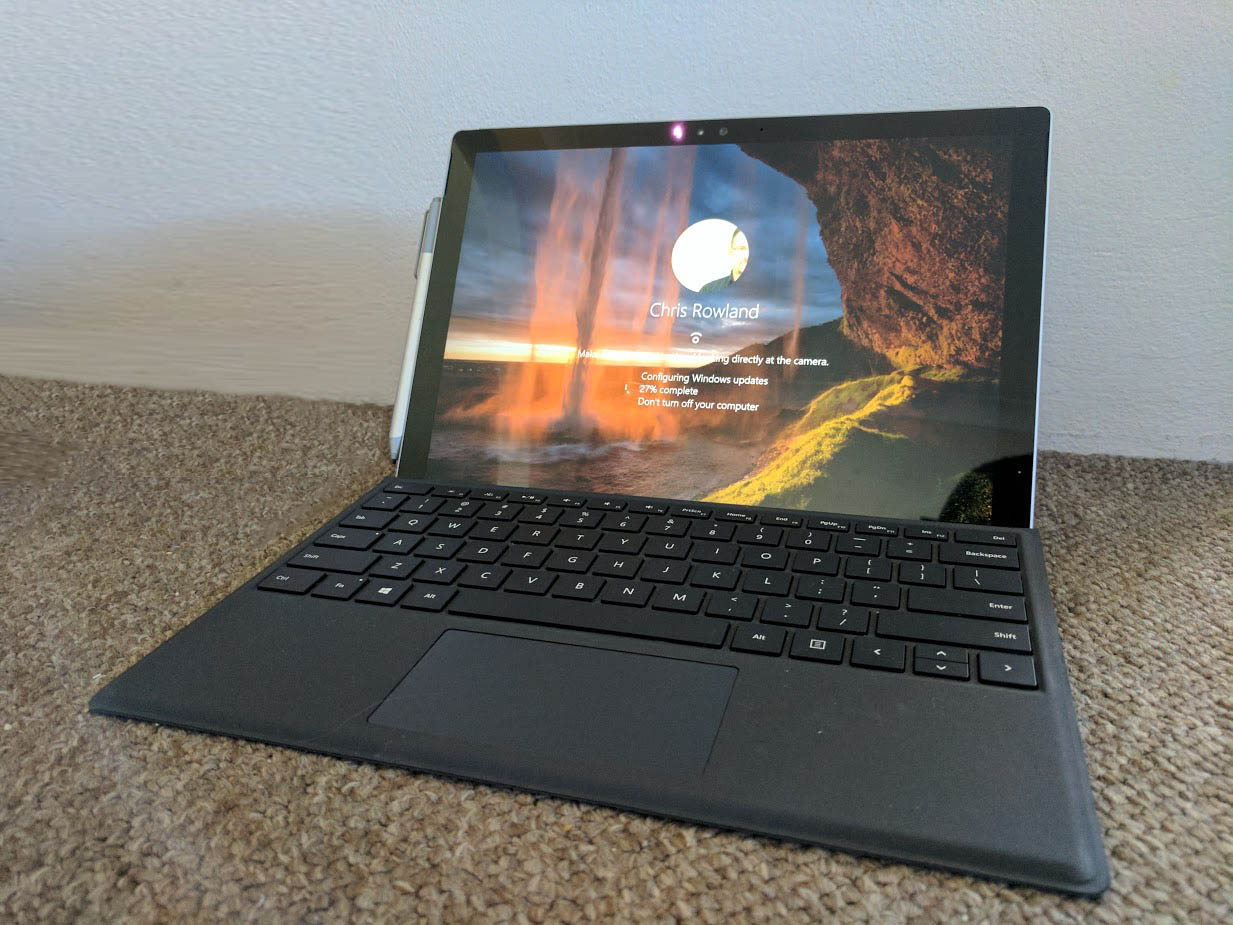

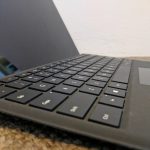
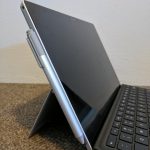
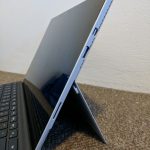
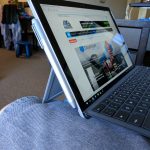
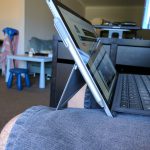



I really like my SP4. After work’s finished, it can handle Skyrim with no problem 🙂
Hey Chris. Great article! You should also include the screen quality as a rated item in the beginning too as the screen in my opinion is far superior than almost anything in existence and is a pretty darn important feature people look for. I’d give the screen a 9.5. What do you think?
I had an iPad 2, then a Nexus 9, and I’ve now got an SP4. It’s my favourite of the bunch. Between normal laptop type use, then pulling off the keyboard, going portrait and reading my digital comics, I love it.
I’ve got an SP3, and while I mostly use it as a student rather than journalist ATM, I agree with the review, it’s spot on.
One thing I should mention, though, is that I use it as a tablet a fair bit, to use Drawboard to mark up PDFs while studying. It’s brilliant to be able to unsnap the keyboard, and just use the pen to highlight passages as you work your way though the research, then close the document and have it slip back into Endnote with annotations. It’s far better as a tablet than I expected, TBH.
bang on target with your surface book recommendation I have an SP4….My wife has a Surface Book for work and it is stunning! I def have tech envy! Realistically, I think it is a better all round proposition for 90% of potential users… has all the touchscreen capabilities of the SP4 … and most of the portability – really is quite thin an light. Sure, the tablet portion is a little bigger than the SP4, how much do people actually use them as stand alone tablets? Not much…we have our androids and (gasp!) ipads for simple media consumption in a… Read more »
i have one- SP4 , i7, 256GB, 16GB RAM. Runs amazingly well and is the best productivity device I have ever used.. IMO you get what you pay for. Would I pay that much for one if i had to buy it myself? (My work purchased it for me).. probably not but i would seriously look at a second hand one on ebay- at around 1k its great value imo. Not great for sitting on your lap though- i’d love another keyboard attachment such as on the surfacebook for times when i have it sitting on my lap (never have… Read more »
I purchased a great Logitech keyboard for mine for $147 from Harvey Norman and it has a built in slot for tablets which works great with the SP4